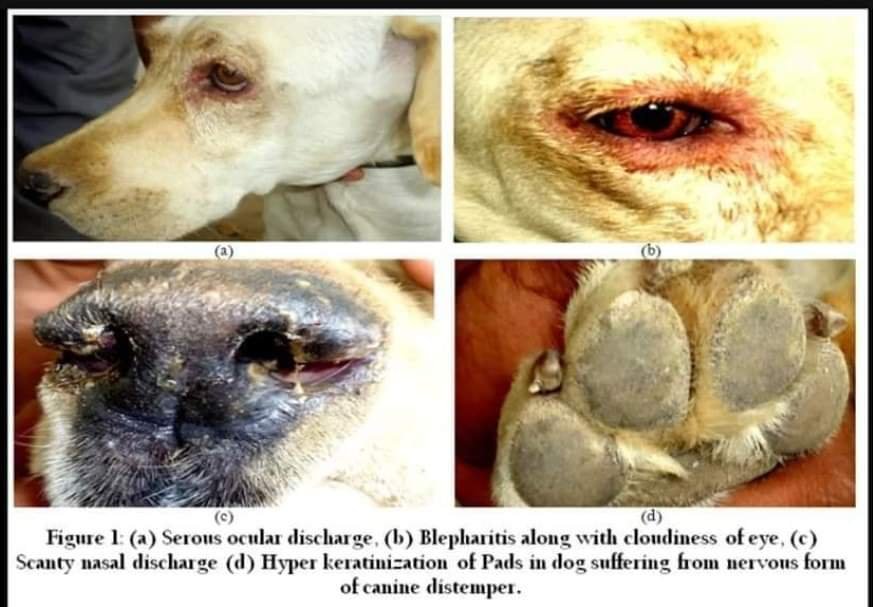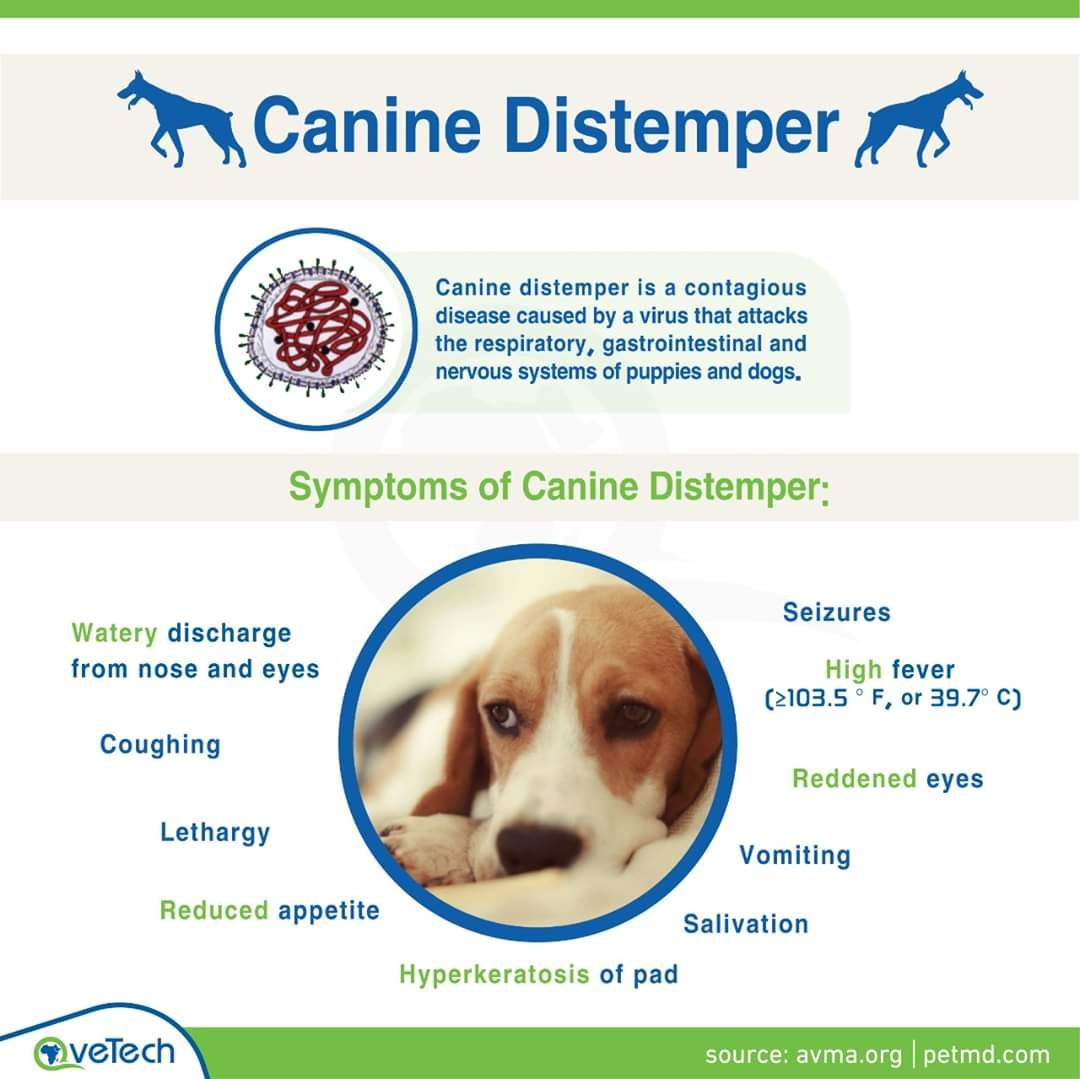Canine Distemper (CD) in Dogs
Dr.Amit Bhardwaj, Small &Large animal surgery specialist,Pune.
Canine distemper is an infection that influences a pooch’s respiratory, gastrointestinal, respiratory and focal sensory systems, just as the conjunctival layers of the eye.
Its epidemiology is complicated by the large number of species susceptible to infection. The disease is seen in Canidae (dog, fox, wolf, raccoon dog), Mustelidae (ferret, mink, skunk, wolverine, marten, badger, otter), most Procyonidae (raccoon, coatimundi), some Viveridae (binturong, palm civet), Ailuridae (red panda), Ursidae (bear), Elephantidae (Asian elephant), primates (Japanese monkey), and large Felidae. Domestic dogs (including feral populations) are considered to be the reservoir species in most, if not all, locations. Antigenic drift and strain diversity is increasingly documented in association with outbreaks in wild species, domestic dogs, and exotic animals held in zoos and parks.
Clinical Findings:
A transient fever usually occurs 3–6 days after infection, and there may be a leukopenia (especially lymphopenia) at this time; these signs may go unnoticed or be accompanied by anorexia. The fever subsides for several days before a second fever occurs, which may be accompanied by serous nasal discharge, mucopurulent ocular discharge, lethargy, and anorexia. GI and respiratory signs, typically complicated by secondary bacterial infections, may follow; rarely, pustular dermatitis may be seen. Encephalomyelitis may occur in association with these signs, follow the systemic disease, or occur in the absence of systemic manifestations. Dogs surviving the acute phase may have hyperkeratosis of the footpads and epithelium of the nasal planum, as well as enamel hypoplasia in incompletely erupted teeth.
Overall, a longer course of illness is associated with the presence of neurologic signs; however, there is no way to anticipate whether an infected dog will develop neurologic manifestations.
Classic neurologic signs include:


localized involuntary muscle twitching (myoclonus, chorea, flexor spasm, hyperkinesia)
convulsions, including salivation and chewing movements of the jaw (chewing-gum fits)
Other neurologic signs include:
*circling
*head tilt
*nystagmus
paresis to paralysis
focal to generalized seizures
Localized involuntary twitching of a muscle or group of muscles (myoclonus, chorea, flexor spasm, hyperkinesia) and convulsions characterized by salivation and, often, chewing movements of the jaw (“chewing-gum fits”) are considered classic neurologic signs. Emerging viral strains may be associated with greater neurotropism; increased morbidity and mortality from neurologic complications has been observed.
A dog may exhibit any or all of these multisystemic signs during the course of the disease. Infection may be mild and inapparent or lead to severe disease with most of the described signs. The course of the systemic disease may be as short as 10 days, but the onset of neurologic signs may be delayed for several weeks or months as a result of chronic progressive demyelination within the CNS.
Clinicopathologic findings are nonspecific and include lymphopenia, with the possible finding of viral inclusion bodies in circulating leukocytes very early in the course of the disease. Thoracic radiographs may reveal an interstitial pattern typical of viral pneumonia.
Chronic distemper encephalitis (old dog encephalitis, [ODE]), a condition often marked by ataxia, compulsive movements such as head pressing or continual pacing, and incoordinated hypermetria, may be seen in fully vaccinated adult dogs without a history suggestive of systemic canine distemper infection. Although canine distemper antigen has been detected in the brains of some dogs with ODE by fluorescent antibody staining or genetic methods, dogs with ODE are not infectious, and replication-competent virus has not been isolated. The disease is caused by an inflammatory reaction associated with persistent canine distemper virus infection in the CNS, but mechanisms that trigger this syndrome are unknown.
Lesions:
Thymic atrophy is a consistent postmortem finding in infected young puppies. Hyperkeratosis of the nose and footpads is often found in dogs with neurologic manifestations. Depending on the degree of secondary bacterial infection, bronchopneumonia, enteritis, and skin pustules also may be present. In cases of acute to peracute death, exclusively respiratory abnormalities may be found. Histologically, canine distemper virus produces necrosis of lymphatic tissues, interstitial pneumonia, and cytoplasmic and intranuclear inclusion bodies in respiratory, urinary, and GI epithelium.
Lesions found in the brains of dogs with neurologic complications include:
neuronal degeneration
gliosis
noninflammatory demyelination
perivascular cuffing
nonsuppurative leptomeningitis, and
intranuclear inclusion bodies predominately within glial cells
FAQ ON CD IN DOGS:
What Are the General Symptoms of Canine Distemper?
The principal indications of canine distemper incorporate sniffling, hacking and thick bodily fluid originating from the eyes and nose. Fever, dormancy, unexpected retching and the runs, misery as well as loss of hunger are additionally side effects of the infection.
How Do Dogs Get Canine Distemper?
The infection is passed from pooch to hound through direct contact with crisp pee, blood or spit. Wheezing, hacking and sharing nourishment and water bowls are on the whole potential ways for the infection to be passed on.
When Is it Time to See the Vet?
Right away! If it’s not too much trouble see your vet immediately on the off chance that you speculate your pooch has been contaminated with the canine distemper infection. The infection spreads quickly and must be forcefully treated when it’s found.
How Is Canine Distemper Diagnosed?
Canine distemper tests do exist, yet the outcomes alone are not constantly solid. Instead of simply testing for the disease, your vet needs to take a gander at the entire picture, including a pooch’s particular manifestations and wellbeing history. Positive outcomes can help affirm a contamination, yet a pooch can in any case be tainted regardless of whether test outcomes are negative.
Which Dogs Are Prone to Canine Distemper?
Little dogs and youthful canines who have not been immunized are generally powerless against the distemper infection. They are commonly protects with obscure immunization accounts or have been purchased from pet stores.
Genuine contaminations are frequently found in pups or pre-adult pooches. Pups more youthful than seven weeks, destined to moms who haven’t been inoculated against the infection, are amazingly helpless. When tainted, pups are seriously debilitated. Frequently the infection goes to the cerebrum, causing seizures, shaking and trembling. A debilitated resistant framework leaves a tainted canine open to optional diseases like pneumonia.
In what manner Can Canine Distemper Be Prevented?
Ensure your pooch has finished his arrangement of inoculations. The antibody for hounds is known as the distemper shot. On the off chance that you have a little dog, ensure he gets his first inoculation at six to about two months old enough. Make certain to get him far from any perhaps irresistible mutts or situations until he’s done with his immunizations at four or five months old.
Likewise, routine cleaning and sanitizing your home (or pet hotel) will guarantee that the infection isn’t in your pooch’s living condition.
By what means Can Canine Distemper Be Treated?
There is right now no accessible prescription that can crush the infection that causes canine distemper. Or maybe, strong consideration is the pillar of treatment. Veterinarians can offer intravenous liquids to forestall lack of hydration and anti-microbials to avoid auxiliary contaminations while the tainted pooch develops his safe reaction. A few mutts can endure the contamination, while for other people, canine distemper can be deadly.
Are There Lasting Health Issues?
Mutts who recuperate from canine distemper may have seizures or other focal sensory system issue that may not appear until numerous years after the fact here and there in their mature age. They may likewise be left with changeless mind and nerve harm, and these manifestations additionally may not appear until some other time.
Reference:On request.


